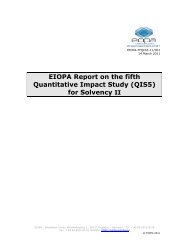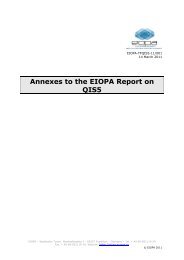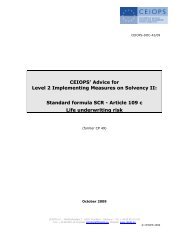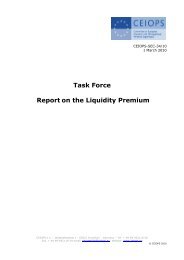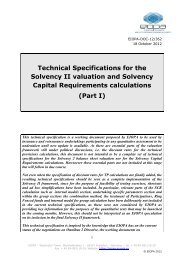Answers to the European Commission on the ... - Eiopa - Europa
Answers to the European Commission on the ... - Eiopa - Europa
Answers to the European Commission on the ... - Eiopa - Europa
Create successful ePaper yourself
Turn your PDF publications into a flip-book with our unique Google optimized e-Paper software.
B.66 The level of premium risk str<strong>on</strong>gly depends <strong>on</strong> <str<strong>on</strong>g>the</str<strong>on</strong>g> expected value of<br />
CY<br />
<str<strong>on</strong>g>the</str<strong>on</strong>g> combined ratio CR . An estimated combined ratio above <strong>on</strong>e<br />
increases <str<strong>on</strong>g>the</str<strong>on</strong>g> risk by <str<strong>on</strong>g>the</str<strong>on</strong>g> estimated loss, whereas an estimated<br />
combined ratio below <strong>on</strong>e decreases <str<strong>on</strong>g>the</str<strong>on</strong>g> risk by <str<strong>on</strong>g>the</str<strong>on</strong>g> estimated profit.<br />
Since insurers tend <str<strong>on</strong>g>to</str<strong>on</strong>g> differ in <str<strong>on</strong>g>the</str<strong>on</strong>g> expected value of <str<strong>on</strong>g>the</str<strong>on</strong>g> combined ratio<br />
of <str<strong>on</strong>g>the</str<strong>on</strong>g>ir business, it seems advisable <str<strong>on</strong>g>to</str<strong>on</strong>g> pers<strong>on</strong>alise this parameter of<br />
CR CY . This could be achieved by estimating <str<strong>on</strong>g>the</str<strong>on</strong>g> expected value of <str<strong>on</strong>g>the</str<strong>on</strong>g><br />
combined ratio of <str<strong>on</strong>g>the</str<strong>on</strong>g> insurer by using <str<strong>on</strong>g>the</str<strong>on</strong>g> his<str<strong>on</strong>g>to</str<strong>on</strong>g>rical ratios.<br />
B.67 As <str<strong>on</strong>g>to</str<strong>on</strong>g> <str<strong>on</strong>g>the</str<strong>on</strong>g> pers<strong>on</strong>alisati<strong>on</strong> of <str<strong>on</strong>g>the</str<strong>on</strong>g> variance of <str<strong>on</strong>g>the</str<strong>on</strong>g> combined ratio, a<br />
number of different approaches seem possible. The determinati<strong>on</strong> of<br />
<str<strong>on</strong>g>the</str<strong>on</strong>g> variance may be left completely, partly or not at all <str<strong>on</strong>g>to</str<strong>on</strong>g> <str<strong>on</strong>g>the</str<strong>on</strong>g> insurer.<br />
The decisi<strong>on</strong> requires a trade-off between accuracy and practicability of<br />
<str<strong>on</strong>g>the</str<strong>on</strong>g> determinati<strong>on</strong> of <str<strong>on</strong>g>the</str<strong>on</strong>g> variance within <str<strong>on</strong>g>the</str<strong>on</strong>g> limits of <str<strong>on</strong>g>the</str<strong>on</strong>g> standard<br />
formula.<br />
B.68 A completely company-specific determinati<strong>on</strong> of <str<strong>on</strong>g>the</str<strong>on</strong>g> variance would<br />
make a high demand <strong>on</strong> <str<strong>on</strong>g>the</str<strong>on</strong>g> insurer. It would require <str<strong>on</strong>g>the</str<strong>on</strong>g> insurer <str<strong>on</strong>g>to</str<strong>on</strong>g><br />
observe <str<strong>on</strong>g>the</str<strong>on</strong>g> volatility of <str<strong>on</strong>g>the</str<strong>on</strong>g> relevant business for a l<strong>on</strong>g period of time<br />
and <str<strong>on</strong>g>to</str<strong>on</strong>g> make an actuarial analysis <strong>on</strong> those data. This approach may<br />
not seem feasible for <str<strong>on</strong>g>the</str<strong>on</strong>g> standard formula.<br />
B.69 The opposite approach would be <str<strong>on</strong>g>to</str<strong>on</strong>g> uniformly fix <str<strong>on</strong>g>the</str<strong>on</strong>g> assumed variance<br />
of <str<strong>on</strong>g>the</str<strong>on</strong>g> combined ratio of a business line for all companies. This opti<strong>on</strong><br />
has been chosen in <str<strong>on</strong>g>the</str<strong>on</strong>g> UK solvency regime. It would not take in<str<strong>on</strong>g>to</str<strong>on</strong>g><br />
account <str<strong>on</strong>g>the</str<strong>on</strong>g> differences between <str<strong>on</strong>g>the</str<strong>on</strong>g> insurers in <str<strong>on</strong>g>the</str<strong>on</strong>g> volatility of <str<strong>on</strong>g>the</str<strong>on</strong>g>ir<br />
combined ratios. In particular, <str<strong>on</strong>g>the</str<strong>on</strong>g> standard formula would not<br />
differentiate between <str<strong>on</strong>g>the</str<strong>on</strong>g> volatility of large and of small portfolios.<br />
B.70 An intermediate approach would be <str<strong>on</strong>g>to</str<strong>on</strong>g> determine <str<strong>on</strong>g>the</str<strong>on</strong>g> variance of <str<strong>on</strong>g>the</str<strong>on</strong>g><br />
combined ratio by referring <str<strong>on</strong>g>to</str<strong>on</strong>g> data which are partly specific <str<strong>on</strong>g>to</str<strong>on</strong>g> <str<strong>on</strong>g>the</str<strong>on</strong>g><br />
company and partly independent from <str<strong>on</strong>g>the</str<strong>on</strong>g> company. For example, <str<strong>on</strong>g>the</str<strong>on</strong>g><br />
Swiss Solvency Test assumes that <str<strong>on</strong>g>the</str<strong>on</strong>g> probability distributi<strong>on</strong> of <str<strong>on</strong>g>the</str<strong>on</strong>g><br />
loss ratio follows a compound poiss<strong>on</strong> distributi<strong>on</strong>. Given a coefficient<br />
of variati<strong>on</strong> for <str<strong>on</strong>g>the</str<strong>on</strong>g> claim size, <str<strong>on</strong>g>the</str<strong>on</strong>g> insurer may calculate <str<strong>on</strong>g>the</str<strong>on</strong>g> coefficient<br />
of variati<strong>on</strong> of <str<strong>on</strong>g>the</str<strong>on</strong>g> loss ratio by estimating <str<strong>on</strong>g>the</str<strong>on</strong>g> expected number of<br />
claims of its portfolio.<br />
B.71 While this approach is quite ambitious, a more pragmatic attempt <str<strong>on</strong>g>to</str<strong>on</strong>g><br />
pers<strong>on</strong>alise <str<strong>on</strong>g>the</str<strong>on</strong>g> determinati<strong>on</strong> of <str<strong>on</strong>g>the</str<strong>on</strong>g> variance is <str<strong>on</strong>g>to</str<strong>on</strong>g> regard <str<strong>on</strong>g>the</str<strong>on</strong>g> variance<br />
as a functi<strong>on</strong> of <str<strong>on</strong>g>the</str<strong>on</strong>g> size of <str<strong>on</strong>g>the</str<strong>on</strong>g> portfolio:<br />
2<br />
( CR ) f ( n)<br />
CY σ = .<br />
B.72 The functi<strong>on</strong> f would be provided by <str<strong>on</strong>g>the</str<strong>on</strong>g> supervisor and <str<strong>on</strong>g>the</str<strong>on</strong>g> size n of<br />
<str<strong>on</strong>g>the</str<strong>on</strong>g> portfolio would be determined individually by <str<strong>on</strong>g>the</str<strong>on</strong>g> insurer. The size<br />
of <str<strong>on</strong>g>the</str<strong>on</strong>g> portfolio could be measured by <str<strong>on</strong>g>the</str<strong>on</strong>g> number of risks in <str<strong>on</strong>g>the</str<strong>on</strong>g><br />
portfolio at <str<strong>on</strong>g>the</str<strong>on</strong>g> beginning of <str<strong>on</strong>g>the</str<strong>on</strong>g> time horiz<strong>on</strong>. This approach would<br />
combine an assumpti<strong>on</strong> <strong>on</strong> <str<strong>on</strong>g>the</str<strong>on</strong>g> volatility of <str<strong>on</strong>g>the</str<strong>on</strong>g> combined ratio which is<br />
specific <str<strong>on</strong>g>to</str<strong>on</strong>g> <str<strong>on</strong>g>the</str<strong>on</strong>g> business line and independent of <str<strong>on</strong>g>the</str<strong>on</strong>g> single company<br />
with <str<strong>on</strong>g>the</str<strong>on</strong>g> diversificati<strong>on</strong> effects caused by <str<strong>on</strong>g>the</str<strong>on</strong>g> size of <str<strong>on</strong>g>the</str<strong>on</strong>g> portfolio which<br />
is specific <str<strong>on</strong>g>to</str<strong>on</strong>g> <str<strong>on</strong>g>the</str<strong>on</strong>g> company. This approach has been chosen by <str<strong>on</strong>g>the</str<strong>on</strong>g><br />
250






